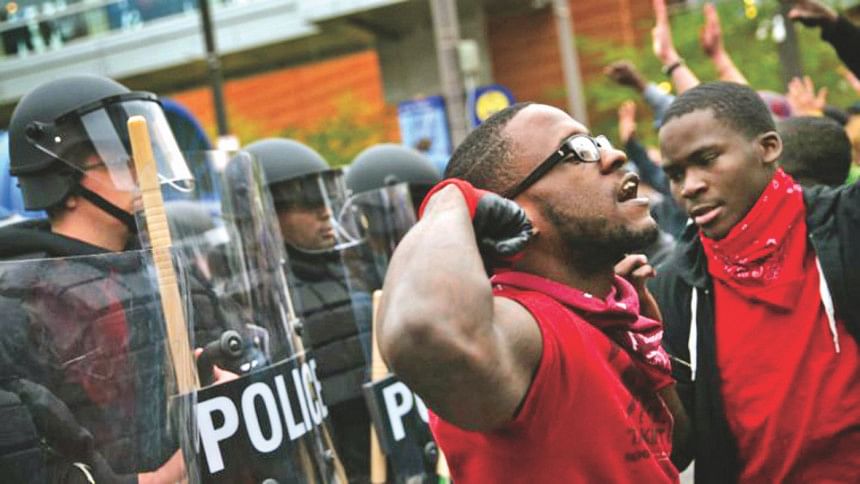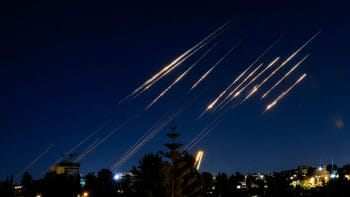Breathing While Black

A photograph was being widely shared on social media on the morning of April 27: a young man had his fist raised in the air as the police stood in formation while a store burned in the backdrop. "Baltimore unrest" were the words written in bold somewhere in the description of the photo. No, this isn't the 1968 Baltimore riot sparked by the assassination of Martin Luther King, Jr. This is the 2015 Baltimore uprising.
Freddie Gray, a 25-year-old African-American man, was taken into custody by the Baltimore Police Department (BPD) on April 12, 2015 for possession of a switchblade. By the time he arrived at the police station within half an hour, he was unable to talk or breathe.
Several eyewitness accounts claimed that unnecessary use of force had been applied on Gray by the police while he was arrested. Gray suffered serious injuries to his larynx and spinal cord. He fell into a coma and died seven days later.
Spontaneous protests spread after his funeral and were soon marred with violence for reasons beyond what you'll see or hear on Fox News. The government's response was nothing extraordinary or unexpected. Curfews and a state of emergency were declared soon after. President Obama pointed out the "worrying interactions between black citizens and the police" -- a gross understatement. Although the President was quick to denounce the violence and looting amidst the protests, he, like many critics, failed to mention that the underlying causes of the uprising go much deeper than Freddie Gray's death. Gray's brutal treatment at the hands of the police is not an isolated incident. The disproportionate amount of force faced by African-Americans compared to their white counterparts is just one of many ways in which institutionalised racism in white America manifests itself.
Bottled up frustration within black communities because of centuries of alienation, discrimination and economic disenfranchisement may explain the climate of anger in Baltimore. Baltimore has a long history of police violence, particularly between the law enforcement and young men of colour. Police in Baltimore killed more unarmed people last year than 93 of the 100 largest US cities. BPD killed five black people and Maryland Transit Authority killed one Hispanic person -- no white person was killed. 100% of people killed by BPD last year were black. Consider this glaring fact: almost a quarter of Baltimore residents (64 percent blacks) live below the poverty line. A City Report study cited that the number of high poverty neighbourhoods -- which are often violent and environmentally hazardous -- in Baltimore shot up from 38 in 1970 to 55 in 2010. Federal, state and local policies catalysed the process of shunning black populations into slums, away from predominantly white middle-class suburbs. State-sanctioned policies of racial segregation of low-income minority families have exacerbated racial tensions in Baltimore.
A glimpse into the reactions of many in social media shows just how deep feelings of animosity run towards the black population in American society as a whole. Teana Walsh, an assistant prosecutor in Wayne County, Michigan, resigned on May 1st after she made a controversial comment on Facebook proposing a "solution" to deal with the violent wave of protests in Baltimore. The post reads: "Simple. Shoot em. Period. End of discussion. I don't care what causes the protesters to turn violent... what the 'they did it because' reason is ... no way is this acceptable. Flipping disgusting." Walsh's comment is reflective of a deep-rooted racist mentality that views black lives as expendable. Others on social media showed no hesitation in painting the uprisings with a wide brush, insensitively calling agitators and looters "lynch mobs", given white America's shameful history of lynching blacks. Here's where drawing the line between peaceful protesters and rioters becomes crucial.
Many continue to highlight the news media's convenient overlook when it comes to white people's sports-triggered riots. For example, after the Denver Broncos' Super Bowl win in 1998, 10,000 fans decided that an appropriate celebration would be to stir up fights in the streets, overturn cars and vandalise public property -- costing the city millions in damages. Just last year, San Francisco Giants fans' "celebrations" turned violent after the Giants beat the Kansas City Royals to win the World Series. As rowdy crowds set debris on fire and smashed bottles on the streets, violence left three injured in separate incidents -- two of whom were injured by gunshots and the other by stabbing. During Hurricane Katrina, as people desperately searched for provisions for food, the media reported that white people "found" food while black people "looted" (Salon) since the latter are considered inherently "less civilised" and therefore "more savage" than the white-skinned.
Michael Brown. Tamir Rice. Trayvon Martin. Eric Garner. These are just a few names in a long list of unarmed black men killed by the police. These men have become symbols of a national conversation about police brutality against men of colour. As Fox News, CNN and conservative pundits pander their viewers and try to steer the conversation away from police brutality and focus on the violence of the rioting instead, activist DeRay McKesson's words come to mind. McKesson, who has been at the frontline of the Black Lives Matter movement, shut down CNN's Wolf Blitzer when the latter tried to derail the conversation away from the larger issue of police brutality by saying, "You are suggesting this idea that broken windows are worse than broken spines… Freddie Gray will never be back. And those windows will be."
The writer is a journalist at The Daily Star.

 For all latest news, follow The Daily Star's Google News channel.
For all latest news, follow The Daily Star's Google News channel. 



Comments